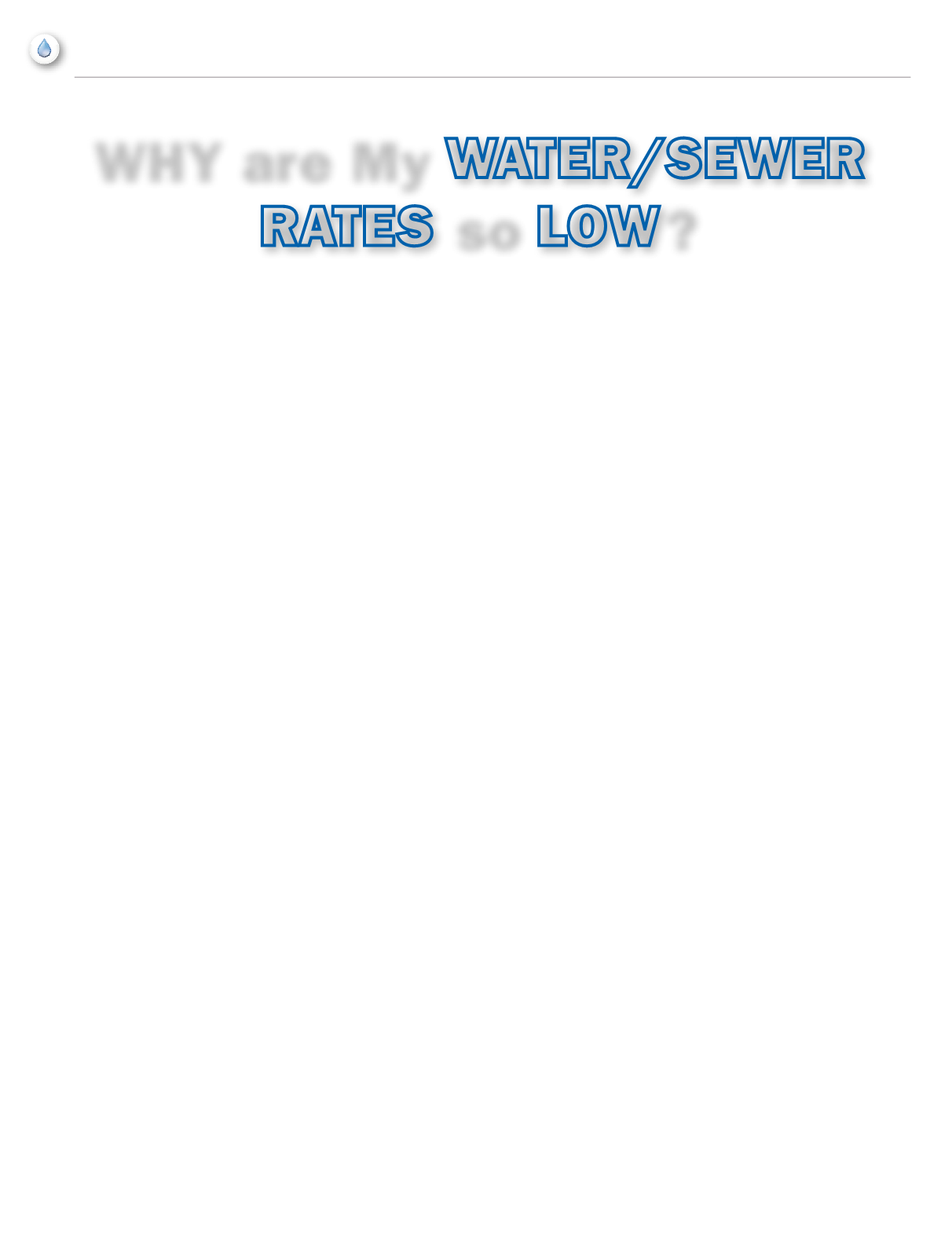
20
NCRWA.COM |
Summer 2014
feature
I
t’s safe to say that in the history of mankind no one has ever asked
“Why are my water and sewer rates so low”. Water/Sewer system
owners, whether they be cities, towns, counties, water districts or
privately owned, typically are accused of charging too much for
their services. The history of how water/sewer rates have been set
in the past has led to the expectation that these services should be
provided for a low price and the rates should not be increased for
the customers until the financial situation is so dire that it absolutely
has to be done (and even then only to the bare minimum). However,
ageing infrastructure replacement costs, regulatory requirements,
lower revenue and rising operational costs are forcing system owners
to raise rates more often and at higher percentages than in previous
times. Because of this there is an increasing perception that water/
sewer service providers are not operating efficiently and therefore
there should be more regionalization and/or privatization of these
services. Before legislators consider changing policies and laws to
push utilities in that direction there should be a factual determination
of how we got to this point and how the current system could change
to address water and sewer problems.
In North Carolina publicly owned water/sewer utility rates (towns,
counties, water/sewer districts) have historically been relatively
low due to an abundance of available water sources, high capacity
water customers and subsidized infrastructure cost. Even small
utilities were able to have low rates for their customers when they
had high capacity industrial customers (such as textile dyeing and
finishing plants) that provided a sufficient and steady revenue stream
generated from high volume industrial water use. Upon passage and
implementation of the Safe Drinking Water Act and Clean Water Act
in the 1970s many of these small towns were able to build or expand
water/sewer infrastructure from partial or full grants provided by the
federal government. Rates for the publicly-owned utilities are set by
local elected officials. These officials endeavored to keep the water/
sewer rates low to attract more industry and growth. As a rule the rates
were set lower than the true cost of providing the service because local
officials did not recognize the long term infrastructure replacement
cost when setting the rate (after all the money for building the
infrastructure was either partially or wholly given to the town through
grants or highly subsidized loans). This strategy worked well for many
years. The growth rate was sufficient to generate enough additional
revenue to offset the inevitable increase in utility operational cost.
The infrastructure was relatively new and did not require excessive
maintenance. When the town attracted new industry there were
grants or subsidized loans available to expand infrastructure. Local
boards became accustomed to not raising water and sewer rates. In
fact it became a matter of pride when a town could boast that they
had no increase in rates over a period of many years. It became the
expectation that water/sewer rates should not be increased.
Unfortunately things changed. Industry, particularly heavy water
using industry, began to leave. Revenues from industrial water and
sewer bills decreased significantly. As industry declined so did the
overall growth rate. Utilities had become dependent on additional
revenue from growth to offset increasing inflation and regulatory cost.
In addition to this, North Carolina began to experience some drought
conditions that generated legislation on water use and a decline
in per capita water usage, effectively reducing water and sewer
revenues for utilities. As all this was occurring it became obvious
that the water and sewer infrastructure that had been built decades
earlier was beginning to reach the end of its useful life. Additional
maintenance cost was needed just to keep the existing infrastructure
viable until replacement/rehab projects could be funded. Since utility
board elected officials and management had not included long term
replacement cost in their rates for decades there was not sufficient
capital reserve funds available to replace the deteriorating systems.
Local elected officials and Federal/State legislators, many still firmly
convinced that water/sewer rates should never have to be increased,
began to debate how to fix the broken water/sewer utility systems.
In the midst of this challenging scenario some have come forward
proposing that an over haul of the water/sewer utility industry is
required to fix the problems that exist. Other options, they opine, are
available for providing these necessary services to our citizens. If local
control of utility systems is not working then perhaps regionalization or
privatization will solve the problems. Is it possible that regionalization
or privatization could replace the ageing infrastructure, continue to
meet all current and future regulatory requirements and supply the
current and future water/sewer service needs of all our citizens without
an increase in cost? Some may argue that it can be done by increasing
efficiency. If this is the case there should be independently researched
WHY
are My
WATER/SEWER
RATES
so
LOW
?
By Marty Wilson, NCRWA


